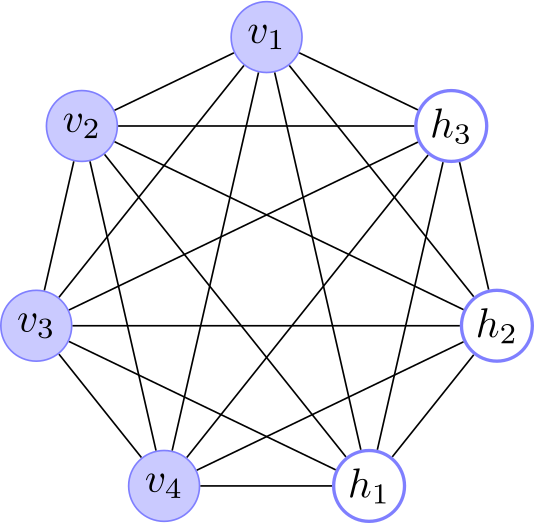Machine Learning
Contents
Communities
IRC FreeNode: ##machinelearning
Getting Started
DeepLearning.TV YouTube playlist -- good starter!
Keras runs on top of TensorFlow or Theano
Tuts
UFLDL Stanford (Deep Learning) Tutorial
Principles of training multi-layer neural network using backpropagation <-- Great visual guide!
http://deeplearning.net/tutorial/ <-- Python code here (Theano)
(Coursera) Neural Networks for Machine Learning — Hinton
- Hinton's homepage
- Coursera course - Intro vid for course - Vids (on YouTube) - same, better organized
- Bayesian Nets Tutorial -- helpful for later parts of Hinton
Code:
- https://github.com/bpjsincl/coursera-neural-net <-- Python - https://github.com/BradNeuberg/hinton-coursera <-- MatLab - https://github.com/davidandrzej/py-coursera-neural <-- no good - https://github.com/Sohojoe/hinton-coursera <-- fork of the Matlab
- https://github.com/mdenil/dropout
- http://www.cs.toronto.edu/~rsalakhu/code.html <-- Boltzmann stuff MATLAB Ruslan Salakhutdinov and Geoff Hinton - https://github.com/echen/restricted-boltzmann-machines Python RBM NICE - http://deeplearning.net/tutorial/rbm.html - http://deeplearning4j.org/restrictedboltzmannmachine.html - Hinton, Salakhutdinov (2006) -- Reducing the Dimensionality of Data with Neural Networks <-- Stacked RBM AutoEncoders (DBM) + CODE!
Exercises:
- https://www.reddit.com/r/MachineLearning/comments/1wgleb/where_can_i_find_the_exercises_to_the_coursera_ml/
Other courses
Deep learning at Oxford 2015 (Nando de Freitas)
Notes for Andrew Ng's Coursera course.
Hugo Larochelle: Neural networks class - Université de Sherbrooke RESOURCES
Karpathy -- CS231n: course here, http://karpathy.github.io/neuralnets/
Trading
(2013) Applying Deep Learning To Enhance Momentum Trading Strategies In Stocks
http://people.idsia.ch/~juergen/finance.html
Books
Nielsen -- Neural Networks and Deep Learning <-- online book
http://www.deeplearningbook.org/
https://page.mi.fu-berlin.de/rojas/neural/ <-- Online book
The Elements of Statistical Learning
S/W
http://playground.tensorflow.org
TensorFlow in IPython YouTube (5 vids)
SwiftNet <-- My own back propagating NN (in Swift)
Stats Courses
OxEduc: Bayesian statistics: a comprehensive course
Misc
Links: https://github.com/memo/ai-resources
http://colah.github.io/posts/2014-03-NN-Manifolds-Topology/ <-- Pics of manifolds!
http://karpathy.github.io/2015/05/21/rnn-effectiveness/
https://www.youtube.com/watch?v=gfPUWwBkXZY <-- Hopfield vid
http://www.gitxiv.com/ <-- Amazing projects here!
https://github.com/ChristosChristofidis/awesome-deep-learning <-- MANY ML Links!
https://blog.keras.io/building-autoencoders-in-keras.html
http://videolectures.net/cyberstat2012_friston_free_energy/
Boltzmann Machines
Hopfield to Boltzmann http://haohanw.blogspot.co.uk/2015/01/boltzmann-machine.html which links to http://arxiv.org/pdf/1510.04781v2.pdf
Hinton's Lecture, then:
https://en.wikipedia.org/wiki/Boltzmann_machine
http://www.scholarpedia.org/article/Boltzmann_machine
Hinton (2010) -- A Practical Guide to Training Restricted Boltzmann Machines
https://www.researchgate.net/publication/242509302_Learning_and_relearning_in_Boltzmann_machines
An Introduction to Restricted Boltzmann Machines (hard)
Boltzmann Distribution
Consider this 'background'.
Suppose you have some system being held in thermal equilibrium by a heat-bath. Now suppose the system has a finite number of possible states. Like a 3x3x3 cm cube containing molecules with total KE 900J, and the states are: {first 1x1x1 zone has 999J, next has 1, others have 0} (very unlikely), {998,1,1,0,...}, etc. Notice we are making (two) artificial discretisation(s). So let's think of the whole cube as the reservoir/heat-bath and the middle 1x1x1 cm zone as our system. (better would be to make our reservoir much larger e.g. 101x101x101 in proportion to our system -- think infinite).
We would expect our system to fluctuate around 100J. We can ask: what is the probability our system has 97J at a given moment? Boltzmann figured out that if you know the energy of a particular state you can figure out the probability the system is in that state:
 where
where  is the energy for that state.
is the energy for that state.
So we can write:  where
where  is the PARTITION FUNCTION (energy summed over all possible states).
is the PARTITION FUNCTION (energy summed over all possible states).
If you graph the energy (X axis) vs probability {system has that energy} (Y axis) you have a Boltzmann Distribution.
Susskind derives this here.
Boltzmann MACHINE
A Boltzmann Machine is a Hopfield Net, but each neuron stochastically has state 0 or 1.
So, imagine a 12 point mystic rose: 3 hidden units, 9 visible units. You can visualise the weights between each pair of units by the thickness of that line if you like.
Retrieval: First imagine the network is already trained to recognise 3 simple shapes, i.e. suppose weights are fixed in such a way that input vectors 111-000-000, 000-111-000 and 000-000-111 generate basins i.e. minima of low network energy (network energy is just the sum of active synapses. So  where i,j both on).
where i,j both on).
So, CLAMP visible units to 111-100-000, set the 3 hidden units to random binary & keep randomly choosing a neuron and updating its state (0 or 1) by some probabilistic logic that will guarantee our system eventually settles down into a Boltzmann distribution, i.e. reaches thermal equilibrium.
This will mean that with high probability it will be in a low energy state. Think: place a marble nearby & it will roll to the nearest basin. So we should be able to recover 000-111-000.
- Now let's cook up that updating logic.
- It looks like Wikipedia's approach here is to suppose the system is already in a Boltzmann distribution & we wish to update it in a way that it is still in a Boltzmann distribution afterwards:
- We can calculate the probability of a given unit's state being ON just by knowing the system's energy gap between that unit being ON and OFF:
 where
where 
- Yup that's a good ole Sigmoid! And it should be simple to get that Energy delta just by figuring out the expected Energy contribution of that neuron.
That demonstrates its retrieval ability. But how about its storage ability?
i.e. If you feed in those three training images, we need some way of twiddling the weights to create 3 appropriate basins. i.e. We want the network to have ultralow energy for those 3 input vectors.
So you want to perform some kind of gradient descent: figure out the rate at which the energy is decreasing as you twiddle your weight. And adjust the weight to get maximum energy decrease.
Hinton describes this process on Scholarpedia: Learning in Boltzmann machines.

Actually is there a simpler way to think of this? The RHS is just the elevation of synapse-load (for this particular synapse) (or 'fire-together' if you like) during training over the same during 'dreaming'. So we want to 'wire-together' in proportion to 'fire together'. This is good ole Hebbian Learning.
Now since  , we have
, we have  which we can write
which we can write 
i.e.  ... struggling to finish this.
... struggling to finish this.
RBM Code
http://stats.stackexchange.com/questions/237373/architecture-of-salakhudinovs-dbm-code <-- Salakh (2010?)
Hinton (2006)
http://science.sciencemag.org/content/suppl/2006/08/04/313.5786.504.DC1
https://www.cs.toronto.edu/~hinton/science.pdf
http://www.cs.toronto.edu/~hinton/MatlabForSciencePaper.html
